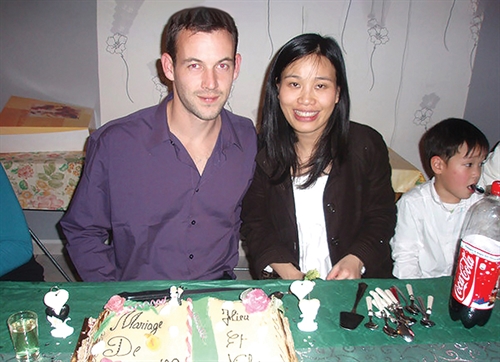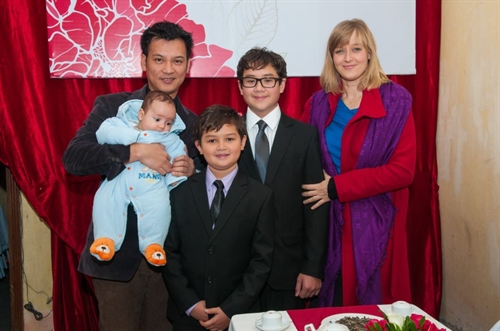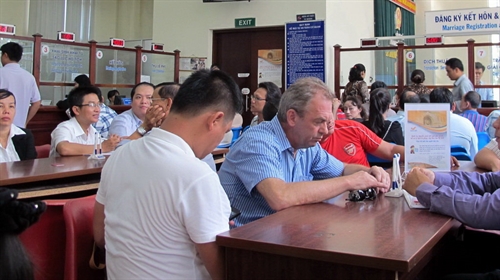I am a foreigner and wish to get married to a Vietnamese woman. What documents do we need and what are procedures for marriage registration?
Her father disapproves of her marriage to a foreigner so he refuses to lend her the household registration book for making marriage registration. Can we make marriage registration without the household registration book?
Marriage registration dossier
As guided in Article 30 of Government Decree 123/2015/ND-CP, a dossier for inter-country marriage registration must be prepared under Article 38.1 of the 2014 Law on Civil Status and comprise:
- A declaration form for marriage registration;
- A document proving the foreigner’s single status, which is issued by his/her country’s relevant authority and remains valid;
In the absence of the above marital status document, a paper certifying that he/she is eligible for marriage in accordance with his/her country’s law can be used as a substitute.
If such document does not state its validity period, it will be considered valid for six months from the date of issuance.
- Certificates issued by a competent Vietnamese or foreign health authority stating that the two marriage registrants suffer no mental illness or another disease which might render them unable to cognize and control their acts;
The above documents must be legalized by the Vietnam-based consular office of the foreigner’s country and enclosed with their notarized Vietnamese translations or bear the translator’s authenticated signature in accordance with Vietnam’s law, and remain valid.
- A copy of the people’s identity card (for Vietnamese citizen residing in the country) or passport or another substitute paper such as laissez-passer or residence card (for foreigners), enclosed with its original for authenticity checking.
- If the marriage registrant being a Vietnamese citizen has divorced or has his/her previous marriage invalidated at a foreign authority, a copy of his/her civil status registration’s page showing the note of divorce or marriage invalidation is required;
- For a civil servant, public employee or serviceman in the armed forces, he/she must submit a document issued by his/her managing unit certifying that his/her marriage with a foreigner is not against the internal regulations of his/her sector or forces.
Though the above marriage registration dossier is not required to have a copy of the household registration book, your wife, as a Vietnamese citizen residing in the country, must still produce to the marriage registration office a copy of her household registration book or temporary residence book (together with the original for authenticity checking) while you, as a foreigner, has to produce your permanent or temporary residence card. This is a compulsory procedure as it helps prove that your marriage registration falls within the competence of the marriage registration office.
 |
| Dang Ngoc Anh, aged 34, from Dong Hoi city, Quang Binh province, and his 26-year-old Irish wife, Michealla__Photo: Internet |
Competence to effect marriage registration
Article 37 of the 2014 Law on Civil Status prescribes that from January 1, 2016, the registration of marriages between Vietnamese citizens and foreigners falls within the competence of district-level People’s Committees of localities where Vietnamese citizens reside.
If you reside in Vietnam, you may request your marriage registration to be carried out by the district-level People’s Committee of the locality where you or your wife reside(s).
Marriage registration procedures
Step 1: The marriage registrants submit a marriage registration dossier directly to the justice division of the district-level People’s Committee of the locality where the Vietnamese citizen resides.
Step 2: The dossier-receiving officer checks documents in the dossier and, if the dossier is valid, issues a dossier receipt stating the date of interview of the registrants and notification of dossier processing results. If the dossier is invalid, the officer instructs the registrants to complete the dossier. The instructions must be recorded in writing clearly stating documents that need to be added. The officer gives his/her signature and full name in the written record to be handed to the registrants.
Step 3: Within 15 working days after the receipt of a valid dossier, the justice division will examine the dossier and verifies the declared information when necessary. Its head is responsible for verification results and the justice division’s proposal on processing the dossier. If finding that the registrants fully satisfy the law-prescribed conditions, the justice division will report such to the chairperson of the district-level People’s Committee for approval of the marriage.
Step 4: When applying for their marriage registration, the registrants must be present at the office of the district-level People’s Committee to answer the civil status officer’s question whether they are willing to enter into marriage. If their answer is “yes”, the registrants will give their signatures in the civil status register and on the marriage certificate.
Within three working days after the district-level People’s Committee’s chairperson signs the marriage certificate, the justice division will hand over such certificate to the spouses.
If the spouses cannot be present together to receive the marriage certificate, they may request the justice division to delay the handover of the certificate for no more than 60 days after it is signed.
Upon the expiration of the 60-day time limit, if the spouses still fail to show up, the justice division will report such to the district-level People’s Committee’s chairperson for invalidating the marriage certificate. If they wish to ask for marriage registration, they have to carry out the above procedures once again.-









